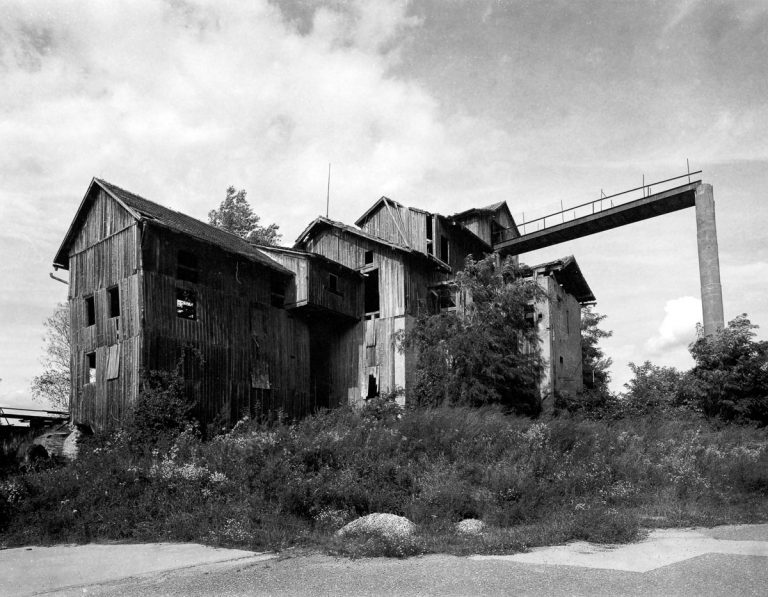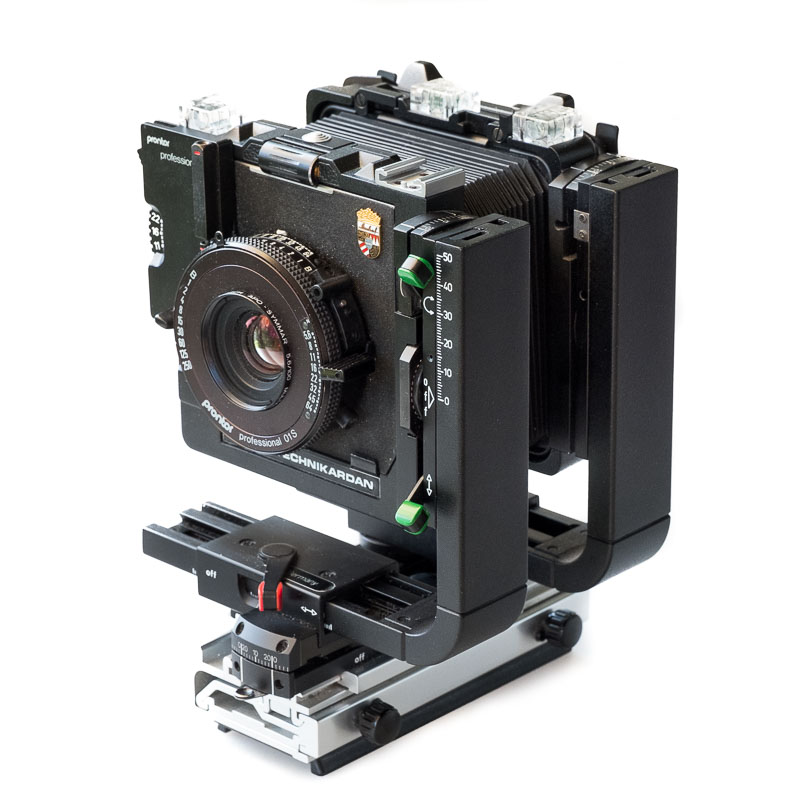The Linhof Technikardan is the smaller of the two Technikardan models. While the Technikardan S 45 can be used for formats up to 9x12 cm or 4x5 inch, respectively, the S 23 has a maximum format of 6,5x9 cm or 2 1/4 x 3 1/4 inch, respectively. The Technikardan S 23 is also still listed in Linhof's product list.
Construction
The Technikardan S 23 is constructed very similar to the Technikardan S 45. Therefore, my description of the larger model is largely valid also for the smaller camera. Accordingly, I describe here only the differences of the construction.
The Technikardan S 23 is somewhat smaller and lighter than the Technikardan S 45. However, despite the similarity the cameras are not modular. Accordingly, it is not possible to upgrade the smaller version to the larger one. In fact, both models share only the lenses and the cold shoe, which serves to hold the compendium. Everything else is specific for the respective model.
Accessories for the S 23 correspond to those of the S 45. This includes standard and wide angle bellows, a stabilizing bracket for large extensions, reflex- and loupe finders as well as roll film backs. Most of these have the same properties as those which I described for S 45. Only the compendium is the same.
Movements
The movements and the maximum extension are adapted to the smaller format.
| Technikardan S 23 | Technikardan S 45 | ||
| Extension (screen-lens board, short extensions require wide angle bellows) | 60 – 350 | 63-425 | |
| Front shift | horizontal | -32 … +25 | -53 … +25 |
| vertical | +50 | -22 … +50 | |
| Rear shift | horizontal | -31 … +26 | -52 … +56 |
| vertical | +50 | +50 | |
| Combined shift (maximum opposite shifts front and rear) | horizontal | -58 … +56 | -109 … +77 |
| vertical | -50 … +50 | -72 … +50 | |
| Size Transport position, no lens, W x H x D | 16,5 x 23 x 12 cm | 22 x 26 x 12 cm | |
| Weight with wide angle bellows | 2850 g | 3130 g | |
These were measured with my cameras.
"-"are movements to the left or down, "+" to the right or up, respectively. With opposite movements, the bellows may limit the movement with short extensions All swings and tilts are limited only by the bellows.
All swings and tilts are limited only by the bellows.
The maximum extenstion is more than adequate even for a 400 mm tele lens. However, the center of gravity is far away from the tripod mount, and the telescopic rail may be stressed accordingly - although to a lower degree than with the longer rail of the S 45. A stabilizing rail may improve this, but since it has te be mounted between camera and tripod socket handling is a bit cumbersome. A 270 mm tele lens may be used without this rail, provided the shutter release does not cause shake.
Back and Roll Film Cassettes
The back is attached with a circular mount, which is also found on the Super Technika 6 x 9 and on the earlier Technika 70. However, because the L standard protrudes on the side, it can not be rotated but has to be detached and re-attached after rotation.
Super Rollex roll film cassettes for 6x7 and 6x9 can be attached to the back. Seen from above, they are not easily differentiated from the corresponding cassettes for 4x5 cameras. Those who intend to purchase a cassette should make sure that the rear has the required circular mount. I can not show this here, because the cassette is actually made for 4x5 and fits only to cameras with a 4x5 graflok back - for example, the Technikardan S 45.
Slide-in Rapid Rollex cassettes are an alternative for 6x7. This is more practical than exchanging the back for a Super Rollex cassette. The Rapid Rollex cassettes are also smaller and lighter. Opposite to the Rapid Rollex for 4x5, the image area is centered. To my opinion, these cassettes are preferrable to the Super Rollex 6x7.
Who should own a Technikardan S 23?
I like precision gear and technical solutions which do not follow conventional routes. The Technikardan offers this. The camera is solid, precision engineered and innovative. The handling of the transport position is not for those whose fingers are all thumbs, but I am impressed by this unconventional and innovative solution. Too bad Linhof does not make digital cameras - they might not be Oskar Barnack's relicts as most others are.
Both Technikardan models are similar, but only the larger model allows to work with 4x5 sheet film or Polaroids. Well, there is a Polaroid back for pack film, but it does not expose the full image area. I use these materials frequently, and accordingly I prefer the Technikardan S 45 or the Technika on the move. As evident from the comparison of the camera backs, the format difference is larger than the camera sizes might suggest. However, 6x7, 6x9 or 2 1/4 x 3 1/4 are also capable to provide excellent results
Unfortunately, sheet film for the Technikardan S 23 is hardly available these days, but I found some panchromatic black and white films. Without guarantee for completeness or future availability, these are:
For 6,5 x 9
- Adox CHSII at 100 ASA
- Fomapan 100 at 100 ASA
- Ilford FP4+ at 125 ASA
For 2 1/4 x 3 1/4 Inch
- Adox CHSII at 100 ASA
- Für 2 Aristo EDU Ultra (Fomapan) at 100 or 400 ASA
- Ilford FP4+ at 125 ASA
- Ilford HP5+ at 400 ASA
- Shanghai GP3 at 100 ASA
Obviously, some films are still being made, but they are hardely offered. I do not add links here becaus this would be rather short-lived.
The internet has some negative comments about the Shanhai film, as well as about Fomapan. I do not know the Shanghai film and can not comment on it, but to my opninion the critique about the Fomapan films is incorrect. I use these films for years without any issue. I am glad these are avaiable, not only because of the favourable prices at good quality but also because Foma manufactures formats others do not care about - as seen above.
The corresponding double dark slide cassettes are also rare and can be found only used at comparably high prices.
Accordingly, the camera is better suited for roll film up to 6x9 or for digital backs. Since 6x9 is only slightly smaller than 6,5 x 9 / 2 1/4 x 3 1/4, this is not a substantial disadvantage.
Pictures on roll film are noticeably cheaper than those on 4x5 sheet film. This holds particularly for colour, which is rather expensive even in smaller sheet film formats. A take on Portra 4x5 colour negative film is currently about 6 to 7 €, plus development in a commercial lab. A roll of Portra 120 costs only slighly more, yet it delivers 8-10 images with only one development. Thus, the more compact S 23 is the better choice for photographers working only with roll film. Those who do not want to be limited to roll film and prefer the noticeably larger 4x5 inch sheet film or a 9x12 panaroma back are better off with the larger model which costs only slightly more.
Not to be overlooked is the option to use the Technikardan S 23 for digital backs. Other cameras which can do less are often much more expensive and require expensive lenses too.
This image was taken with the Technikardan S 23. It was taken with a Super Angulon 5,6/38 XL with perspective correction on Ilford Pan F, 6x7 Rapid Rollex. Composing the image is not as easy as with 4x5 inch, but obviously it can be done.

Disclaimer
I provide this information solely because I like photography and because it may be useful. I have no commercial relationships to any vendor or manufacturer mentioned in this post. The camera and all supplementary parts are my personal property.

26. July 2021 Author Tobias Kopp
Hallo Herr Vorberg,
vielen herzlichen Dank für diesen informativen Artikel!
Sie schreiben, dass die 23 auch mit einem Digital-Rückteil betrieben werden kann – davon wusste ich bis jetzt noch nichts und finde auch keine weiteren Infos. Können Sie helfen? Und: ist dies auch mit der 45 möglich?
Vielen Dank im Voraus!
26. July 2021 Author ewald
Hallo Herr Kopp,
wer digitale Rückteile an einer Kamera mit erweiterten Einstellmöglichkeiten einsetzen möchte, findet dazu tatsächlich hauptsächlich Informationen über technische Kameras. Obwohl die Technikardan 6×9 als Fachkamera noch weitergehende Einstellmöglichkeiten bietet, sind deren Einsatzmöglichkeiten als Digitalkamera nur wenig bekannt. Sie ist aber zu einem Bruchteil der Kosten sehr gut als Panoramakamera oder als verstellbare Kamera einsetzbar. Die Kamera selbst ist zwar nicht billiger als manche der technischen Kameras, aber wer nicht gewillt ist, die hohen Kosten für hochauflösende Rückteile und Objektive zu zahlen, kann sie bestens mit vorhandenen Rückteilen oder Objektiven ohne jedes weitere Spezialzubehör einsetzen. Wer ein high-end System einsetzt, mag das belächeln. Aber wer es ausprobiert, wird feststellen, dass man mit der Technikardan, einem älteren Rückteil und Objektiven aus analogen Zeiten eine bessere Qualität erreichen kann als mancher wohl vermutet. Am ehesten kann damit eine Cambo Actus konkurrieren, aber wer auch mit Film fotografieren möchte oder eine Technikardan bereits besitzt, ist damit bestens bedient.
Die 100 MP Panoramaaufnahmen in meinem Portfolio sind mit der Technikardan S23 und einem Phase One P45+ erstellt. Sie haben eine Qualität, die auch große Drucke ermöglicht, ohne dass daran jemand etwas aussetzen wird. Auch Tabletop Stitching-Aufnahmen mit Tilt habe ich schon gemacht; das geht auch erstaunlich gut.
Die Technikardan 4×5 kann auch mit Digitalrückteilen verwendet werden. Da ich keinen Adapter dafür besitze, kann ich das aber nicht abschließend beurteilen. Es gibt zwar einen Graflok-Adapter von Linhof, aber nur für Hasselblad V Rückteile. Schiebeadapter für Graflock gibt es auch, aber sie lassen sich wegen der Konstruktion der Rückstandarte an der Technikardan nicht verwenden. Ich gehe zudem davon aus, dass die Technikardan 6×9 mit kürzeren Brennweiten eingesetzt werden kann als die Technikardan 4×5.
Ich plane einen Blog-Beitrag mit vielen Detailinformationen zur Technikardan 6×9 mit Phase One Rückteil. Weil ich dafür schon einiges verfaßt habe, schicke ich Ihnen den Entwurf zu.
Viele Grüße, Ewald